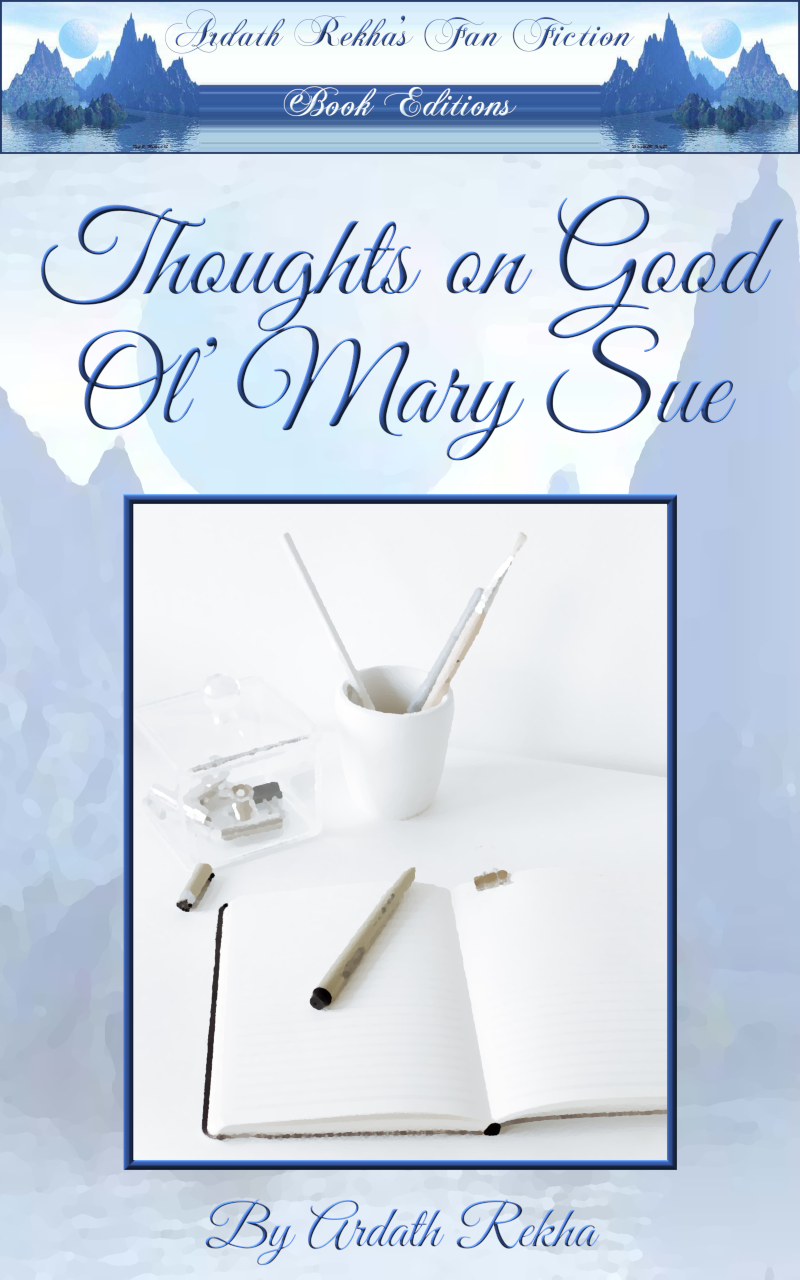Thoughts on Good Ol’ Mary Sue
By Ardath Rekha
Synopsis: The discussion of what turns an original character, added into a work of fan fiction, into a “Mary Sue” has gone on for years. Here’s my contribution from 2003.
Category: Non-Fiction
The views expressed in these articles are solely the views of Ardath Rekha. References to specific works, actors, and writers are done in keeping with the Digital Millenium Copyright Act’s fair use policies. eBook design and cover art by LaraRebooted, drawn from a photo by Ann Nekr, licensed through Pexels, the Great Vibes font from 1001 Fonts, and background graphics © 1998 Noel Mollon, adapted and licensed via Teri Williams Carnright from the now-retired Fantasyland Graphics site (c. 2003). This eBook may not be sold or advertised for sale. If you are a copyright holder of any of the referenced works, and believe that part or all of this eBook exceeds fair use practices under the Digital Millennium Copyright Act, please contact Ardath Rekha.
Rev. 2022.10.09
Thoughts on Good Ol’ Mary Sue
I was cleaning through some files when I found this rumination I started a while back. It’s not half-
The question of Mary Sue is always an interesting one. What defines Mary Sue is subjective and somewhat arbitrary in the minds of the readers, but here’s the clincher:
When we read fiction, generally what pulls us into a story is our ability to identify with the protagonist. We look at her (or him) and see some aspect(s) of ourselves. We understand to some degree, at least, how they are approaching a situation, why they think what they think, why they do what they do.
The Mary Sue “factor” is a barricade between the author’s protagonist and the reader. These are qualities of the character that repel that identification and prevent a reader from responding.
Mary Sue is about self-insertion, but it’s also about writing ourselves not as we are, but as we wish we were. We write ourselves with all of the qualities we’ve coveted and lacked, that would have saved the day for us at various times in our lives. It can be as simple as having our character walk into a party and (unlike us) nobody else is wearing the same dress she
But while we can all probably identify with being the one who looks like the “pathetic twin” in the fashion contest, or who was tongue-tied and devastated in a verbal match, and we all did wish we hadn’t
There are many professional writers who “get away” with writing Mary Sues. Anne McCaffrey comes to mind, as much as I love her writing. Many of her characters are a little too perfect, too glamorous, or too sweet and pure and innocent, and their battles are traditionally with someone who is a little too
And a certain degree of self-insertion is inevitable – after all, the cardinal rule of writing a good story is “write what you know.”
But that’s often what does not happen with a Mary Sue. The author writes not about the things she understands, but about the things she’s imagined and dreamed of but has no concrete experience with.
Her character is the wittiest girl ever, something she’s always longed to be, but because her wit is what the character has to draw from, it falls flat for readers, because most of the material is still simplistic or recycled.
Her character is super-fashionable, owning all the clothes she’s always longed
Her character has the body she’s always dreamed of
Her character is a superintelligent scientist, but both the character and the writer mess up some basic science facts in the very first chapter. (And as an aside, this is the plague of science fiction, and part of why the genre as a whole doesn’t get the credibility it
And above all, her character’s flaws are unrealistic – the quick temper that somehow never makes people decide they’re done with her is a perfect example – and somehow get redeemed by the story because they are turned to her advantage in some way.
It’s more interesting to feel – and empathize with – a character’s deep insecurity, her sense that she’s just been shown up by someone else, her awareness that a situation is totally out of her control and is probably going to stay that
Mary Sue draws writers to her because she’s the woman we all secretly wish we could be. But she also repels readers from her because she’s also the woman we all secretly wish would drop dead.
August 22, 2003


